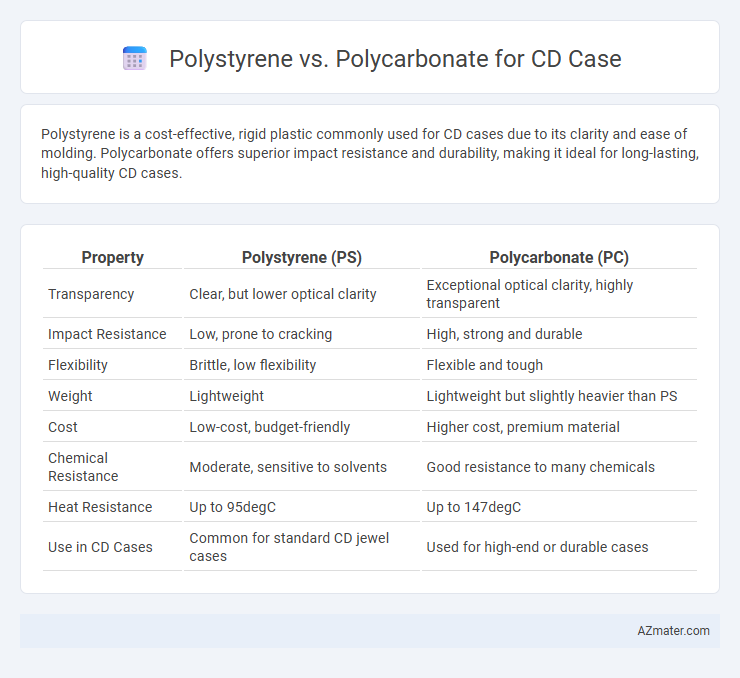Polystyrene is a cost-effective, rigid plastic commonly used for CD cases due to its clarity and ease of molding. Polycarbonate offers superior impact resistance and durability, making it ideal for long-lasting, high-quality CD cases.
Table of Comparison
| Property | Polystyrene (PS) | Polycarbonate (PC) |
|---|---|---|
| Transparency | Clear, but lower optical clarity | Exceptional optical clarity, highly transparent |
| Impact Resistance | Low, prone to cracking | High, strong and durable |
| Flexibility | Brittle, low flexibility | Flexible and tough |
| Weight | Lightweight | Lightweight but slightly heavier than PS |
| Cost | Low-cost, budget-friendly | Higher cost, premium material |
| Chemical Resistance | Moderate, sensitive to solvents | Good resistance to many chemicals |
| Heat Resistance | Up to 95degC | Up to 147degC |
| Use in CD Cases | Common for standard CD jewel cases | Used for high-end or durable cases |
Introduction to CD Case Materials
Polystyrene and polycarbonate are two common materials used in CD case manufacturing, each offering distinct properties impacting durability and clarity. Polystyrene is lightweight and cost-effective but more brittle, making it prone to cracking under stress. Polycarbonate provides enhanced impact resistance and superior optical clarity, ideal for protecting CDs while maintaining visual appeal in packaging.
Overview of Polystyrene
Polystyrene is a versatile thermoplastic polymer commonly used for CD cases due to its low cost, ease of molding, and excellent rigidity. It offers a lightweight yet clear material that provides adequate protection against dust and minor impacts, making it suitable for standard CD packaging. Despite its brittleness compared to polycarbonate, polystyrene remains favored for economy and widespread availability in CD case production.
Overview of Polycarbonate
Polycarbonate is a durable, impact-resistant thermoplastic often used in CD cases due to its high transparency and excellent strength compared to polystyrene. It offers superior shatter resistance and can withstand higher temperatures, making it ideal for long-term protection of discs. Its lightweight nature combined with scratch resistance enhances the overall durability and aesthetic appeal of CD cases.
Physical Properties Comparison
Polystyrene exhibits higher brittleness and lower impact resistance compared to polycarbonate, making it more prone to cracking under stress in CD case applications. Polycarbonate offers superior strength, excellent toughness, and better thermal stability, enhancing durability and resistance to deformation. The optical clarity of polycarbonate also surpasses that of polystyrene, ensuring clearer visibility of CD artwork and labels.
Durability and Impact Resistance
Polycarbonate exhibits superior durability and impact resistance compared to polystyrene, making it ideal for CD cases requiring long-term protection. Polycarbonate's high tensile strength and ability to absorb shocks prevent cracking and shattering, whereas polystyrene is more brittle and prone to damage under impact. For applications demanding robustness and repeated handling, polycarbonate offers enhanced reliability and extended lifespan.
Clarity and Aesthetic Appeal
Polycarbonate offers superior clarity compared to polystyrene, providing a more brilliant and transparent finish ideal for high-quality CD cases. Polystyrene tends to yellow and become brittle over time, whereas polycarbonate maintains its optical clarity and resists scratches, enhancing long-term aesthetic appeal. The enhanced durability and clarity of polycarbonate make it the preferred choice for premium CD packaging where visual presentation is crucial.
Cost Analysis
Polystyrene CD cases are generally more cost-effective due to lower raw material prices and simpler manufacturing processes, making them popular for mass production. Polycarbonate cases, while more expensive, offer enhanced durability and impact resistance, justifying the higher initial investment for premium or reusable packaging. The cost difference can influence budget decisions, with polystyrene favored for budget constraints and polycarbonate chosen for quality and longevity.
Environmental Impact and Recyclability
Polystyrene CD cases pose significant environmental challenges due to their non-biodegradable nature and difficulty in recycling, often ending up in landfills or oceans. Polycarbonate offers better recyclability as it can be processed into new plastic products and has a longer lifecycle that reduces waste. Choosing polycarbonate over polystyrene minimizes plastic pollution and supports more sustainable lifecycle management in CD case manufacturing.
Suitability for CD Protection
Polystyrene offers excellent scratch resistance and clarity, making it suitable for preventing physical damage to CDs, but its brittleness can lead to cracking under impact. Polycarbonate provides superior impact resistance and durability, ensuring better long-term protection against drops and deformation, while maintaining adequate optical clarity. For CD cases requiring enhanced shock absorption and longevity, polycarbonate is the more suitable material choice.
Conclusion: Choosing the Right Material
Polystyrene offers cost-effective, lightweight properties suitable for standard CD cases, while polycarbonate provides exceptional durability and impact resistance ideal for premium or reusable cases. The choice depends on balancing budget constraints with the need for long-term protection and clarity. For high-quality CD cases requiring enhanced strength and scratch resistance, polycarbonate is the superior material, whereas polystyrene remains favorable for economical, disposable options.

Infographic: Polystyrene vs Polycarbonate for CD Case
 azmater.com
azmater.com